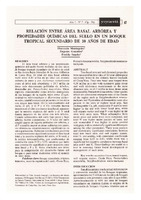Relación entre área basal arbórea y propiedades químicas del suelo en un bosque tropical secundario de 10 años de edad
Date
1996-05-01Author
Montagnini, Florencia
González, Eugenio
Sancho, Freddy
Metadata
Show full item recordAbstract
El área basal arbórea y las propiedades químicas del suelo fueron medidas en tres sitios de bosque tropical secundario de 10 años de edad en las tierras bajas húmedas de la zona atlántica de Costa Rica. El total del área basal arbórea varía entre 4,34 m2/ha en un sitio con extensa cubierta de pasto y con Alchornea costarricenses como el árbol más abundante, y 24,7 m2/ha en área más densamente pobladas de árboles, dominadas por Pentaclethra macroloba. Otras especies consideradas como árboles emergentes de los bosques de la región, tales como Stryphnodendron microstachyum y Hyeronima alchorneoides, también estuvieron presentes en los sitios con mayor área basal. En Ca intercambiable del suelo, pH, y el P y el Cu extraíble fueron mayores en los sitios con menor área basal, mientras que la materia orgánica del suelo y el N total fueron mayores en los sitios con más árboles. Cuando submuestras del suelo bajo pasto y bajo árboles fueron comparadas, el N total del suelo resultó mayor en lugares poblados con árboles, y el P extraíble mayor en áreas cubiertas por pasto, sin diferencias estadísticamente significativas en otros parámetros. Hubieron correlaciones positivas y estadísticamente significativas entre el área basal total y la materia orgánica del suelo, el N total, y la acidez intercambiable con coeficiente de correlación entre 0,33 y 0,52, mientras que hubo una correlación significativa pero negativa entre área basal y P y K. Estos resultados son útiles para la comprensión del desarrollo futuro del bosque o para tomar decisiones sobre el manejo de tales áreas. Thee basal area and soil chemical properties were measured at three sites of 10-year-old tropical secondary forest in the Atlantic humid lowlands of Costa Rica.
Total tree basal area tanged from 4.34 m2 / ha in a site with extensive grass cover
and with Alchornea constaricensis as the most abundant tree, and 24.7 m2 / ha in more dense áreas dominated by Pentaclethra macroloba. Other species which are considered as emergent trees of the forests of the región such as Stryphnodendron microstachyum and Hieronima alchorneoides, were also present in the sites with of highest basal area. Soil exchangeable Ca, pH, extractable P and Cu were higher in the sites with lower basal area, while soil organic matter and total N were higher in the sites with more trees. When
sub-samples from under grass and under trees were compared, soil total N was higher under parches of trees, and extractable P was higher in areas covered with grass, with no statistically significant differences among the other parameters. There were positive and statistically significant correlations between total tree basal área, and soil organic matter, total N, and acidity, with a correlation coefficient ranging from 0.33 to 0.52, while there was a significant but negative correlation between basal área and P and K. These findings are useful as a tool in assessing future forest development or management of such areas.
Collections
- Revista Yvyraretá [360]
The following license files are associated with this item:




